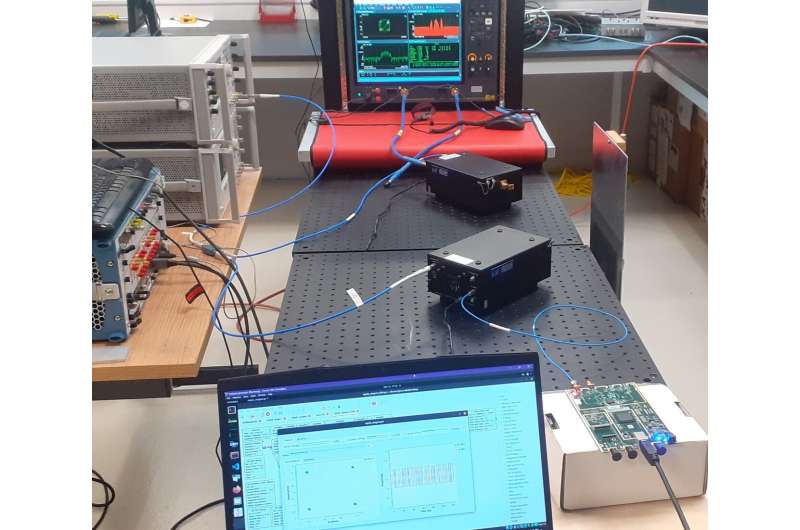November 20, 2023 dialog
This article has been reviewed according to Science X's editorial process and policies. Editors have highlighted the following attributes while ensuring the content's credibility:
fact-checked
preprint
trusted source
written by researcher(s)
proofread
Low-cost adaptable testbed design for terahertz technology

Terahertz communication will shape the future of wireless networks. Extensive high data rates with secure networks are possible with terahertz technology. However, such a high frequency also presents well-known challenges, such as limited range and susceptibility to atmospheric absorption.
The challenges and opportunities can only be seen with feasible and versatile testbeds. Our study, currently available on the arXiv preprint server, is inspired by the question "What do we really know about terahertz communication?"
Software-defined radios
Over the past decade, software-defined radios (SDRs) have emerged as a pivotal radio technology, used to explore the constraints of wireless technology in real-world environments. These radios validate theoretical concepts and pinpoint design bottlenecks that may remain elusive in purely theoretical studies. SDRs are now widely popular even in daily life, serving as accessible tools from spectrum analysis to peer-to-peer walkie-talkies. The capabilities of these radios are immense, making them a perfect fit as a multitasking tool for terahertz wireless designs.
The remarkable versatility of these radios has led to the evolution of novel CubeSat and low-profile transceiver designs within satellite networks, which are transitioning toward SDRs. In this way, remotely controllable and sustainable satellites can be operated without building from the ground up. This design also serves to illuminate the front of terahertz-based satellites.
Until now, terahertz experiments necessitated the use of expensive equipment for implementing and analyzing terahertz communication. We introduce a low-cost, feasible, and adaptable testbed design that unveils the true capabilities of terahertz technology.
SDR-supported terahertz testbeds are the missing piece in this field of study, and they can validate numerous types of research with simplicity and cost-effectiveness. One of the most promising advantages of this design is the fully open-source digital design database, thus opening up a vast realm for experimental research. We believe that it is the first step of a journey of a thousand miles in this field.
Hidden challenges and opportunities
Angular resolution and signal bandwidth become very high and can be manipulated to our benefit via terahertz technology. On the downside, ultra-broadband signal processing represents a major demand. SDRs can easily segregate the real-time process and transfer the non-real-time processing load to powerful computers.
Information sampling is a critical, well-known challenge in terahertz communication. Current SDRs support up to 6.4 Gbits per second, yet more is required. Our design brings to light a previously overlooked issue: frequency sparsity. The frequency extension loses frequency resolution, which leaves windows of non-operative bands. This issue raises concerns about ongoing multiband terahertz designs.
On 6G, various electromagnetic reflector structures will be a part of daily life. A reflector is able to steer the wave characteristics, including the direction of the wave. One use of the reflectors is physically secure connectivity among peers. In the nature of terahertz, a network can be secured by a simple reflector structure. An interesting result is that scattering over a reflector can be both destructive and constructive. Likewise, many exciting hidden opportunities are discussed in our study that could lead to the search for novel, self-describing models.
What comes next?
We have a long history of wireless testbed designing and prototyping that uncovers the true potential of proposed solutions from all around the world. Multi-antenna techniques, beam management, intelligent surfaces, and active and passive sensing are just some of the applications that can be built on this testbed without the need for major investment.
These empirical studies will advance the standardization of terahertz communication in the next step. An era is imminent when the transmission of big data in daily life will be executed in the blink of an eye.
This story is part of Science X Dialog, where researchers can report findings from their published research articles. Visit this page for information about ScienceX Dialog and how to participate.
More information: Eray Guven et al, Terahertz Communication Testbeds: Challenges and Opportunities, arXiv (2023). DOI: 10.48550/arxiv.2311.01972
Eray Guven received a B.S. degree in electronics and communication engineering from Istanbul Technical University, Istanbul, Türkiye, and he was a visiting researcher at A.A. Kharkevich Institute, Russia in 2018. He is currently a Ph.D. candidate in electrical engineering at Polytechnique Montreal, Montreal, QC, Canada.
Gunes Karabulut Kurt is currently an Associate Professor of Electrical Engineering at Polytechnique Montreal, Montreal, QC, Canada. She is a Marie Curie Fellow and received the Turkish Academy of Sciences Outstanding Young Scientist (TUBA-GEBIP) Award in 2019. She received her Ph.D. degree in electrical engineering from the University of Ottawa, ON, Canada.



















